I have a 3D printer. Well, actually 3, but who is counting? The other night I saw a new project upload on Thingiverse for a Back Load Horn Speaker. It was so cool and I knew I had to try it. And besides, I had an actual need as I had just purchased a Uniden SDS200 Police Scanner and it had a little internal speaker that was mounted on the bottom of the case. It screamed for a powered, external speaker. Win, win.
The first thing I’d like to say about the project is I didn’t quite need all the bells and whistles the designer did. He set his up as bluetooth speakers and that is darn cool, no doubt. I just didn’t need to do that. I just needed a powered external speaker.
The back panel is designed for a stereo amp board which the developer lists a source in China that costs a few bucks. The exact same board can be had on Amazon for about $14. Getting 2 day delivery is worth it to me. The parts from China probably wouldn’t show for weeks.
Anyway before you build and wire these you kind of need to know how you are going to deploy them. Let me elaborate.
If you want a set of stereo speakers you ONLY NEED ONE BOARD that I linked above. However the two speakers will be married by a piece of wire running between them. One speaker will have the amp board installed and the other speaker will just be connected to that speaker but by a long piece of wire. I had a set of computer speakers like that once. I HATED THAT. Of course you could put connectors of some kind on the speaker wires coming out of the back to mitigate that problem.
If you put boards in both speakers essentially you will have 2 separate powered speakers. That is essentially what I wanted. Ham radios and police scanners broadcast in Mono, not stereo.
At any time though it would be super easy to remove the back panel and wire them up anyway that you wish.
If you don’t put an amp board in one speaker then you will have a bunch of holes in the back panel. You can either remix the back panel to be without any holes or just one hole for your speaker wire. Or you can just electrical tape up the holes or put black vinyl over them. It’s the back, who cares?
There are multitudes of small amplifier boards out there so I drew up a simple circuit in Fritzing. Most boards will be the same with a power input, audio input, and audio output. Again, if you use a different board the holes in the back panel won’t match. Not really a big deal. And 3D printer geeks want to make these speakers but I’ve seen a couple “How the heck do I wire these up posts?”.
Here’s how. Take note the inclusion on my 2nd speaker here. Again, all you need in the 2nd speaker is just a wire running from the 1st speaker to the 2nd speaker. No board, no parts, no nothing provided speaker 1 has a stereo board in it. If you are making a single powered speaker just pick a side. Right or Left.
I put a separate switch on mine even though the amp board was switched. Hey, there was a hole in the back of the panel already for one. Actually I didn’t have any rectangular mini rocker switches so I enlarged the hole that was there and drilled a 13/16″ round hole and mounted a round rocker switch. Pretty slick, huh? I drilled another hole to let the USB cable input wiring in.
Here’s what it looks like built up. I put some dampening material below the speaker. That should improve and tighten up the bass a hair. You can see the USB cable coming into the box. I used fancy solder slices to connect the wiring. Twisting wires together and electrical taping them is BAD PRACTICE. Don’t do it. Do it right. Use wire nuts or something but not tape.
Printing the enclosure was a snap but it took 26 hours and 45 minutes PER BOX!
All that is left to do is to make some side panels. While you’re looking at a guy not scared to try to fix anything………woodworking scares me. I don’t know why. I don’t have the tools and I LACK CONFIDENCE in my ability to do it. You can 3D print the panel sides but old John is also an audiophile. Plastic and sound isn’t very resonant. You need some wood. Mid density would be best but hell any wood will improve things a bit over plastic.
Here’s what I did. I half printed a side panel. Then I went to Lowes and bought some 1/4″ oak plywood. With a JigSaw and a clean (fine) blade I cut out 200mm x 150mm rectangles. Then I clamped the wood pieces, one at a time to the partial side panel I printed and I used a powered sander to make the radius and to make the panels the perfect size.
Somehow or another stunningly it turned out really nice. I’m not the rotten woodworker I thought I was. In fact they look GOOD. I put one light coat of poplar stain on them.
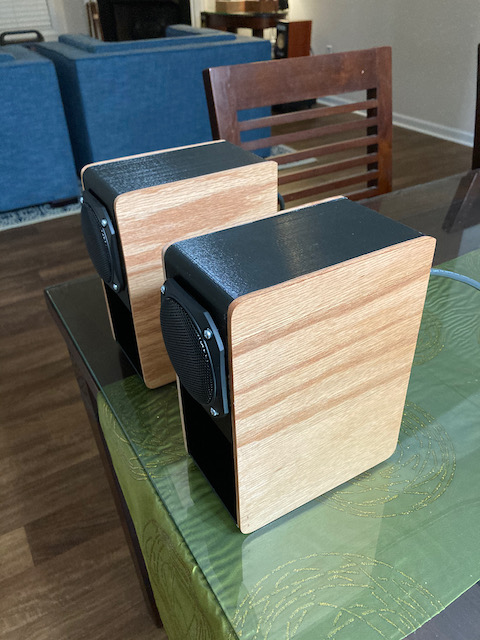
Finished Product

Finished Product
Oh by the way…..when I bought the speakers I got them from Parts Express and I went ahead and sprang for the grills rather than 3D print the speaker flanges in the original project. I think it looks a lot sharper. We do good work over here at John’s Tech Blog.
If you really want to get fancy with these you could put a Raspberry Pi Zero W with an amp board attached to the top of it. Then you could put Logitechmediaserver and Squeezelite on it and make it a STREAMING DEVICE. Yep, Spotify, Pandora, Tidal, TuneIn. Might be worth looking into. That would be a stand alone system.
If you have a 3D printer this is without a doubt a must do project. For a DIY maker dude it has all the stuff. 3D printing, soldering, wiring, electronics, woodworking, glueing……….a lot of tangible skills in this one.

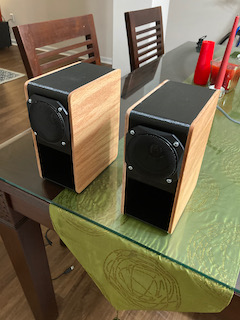
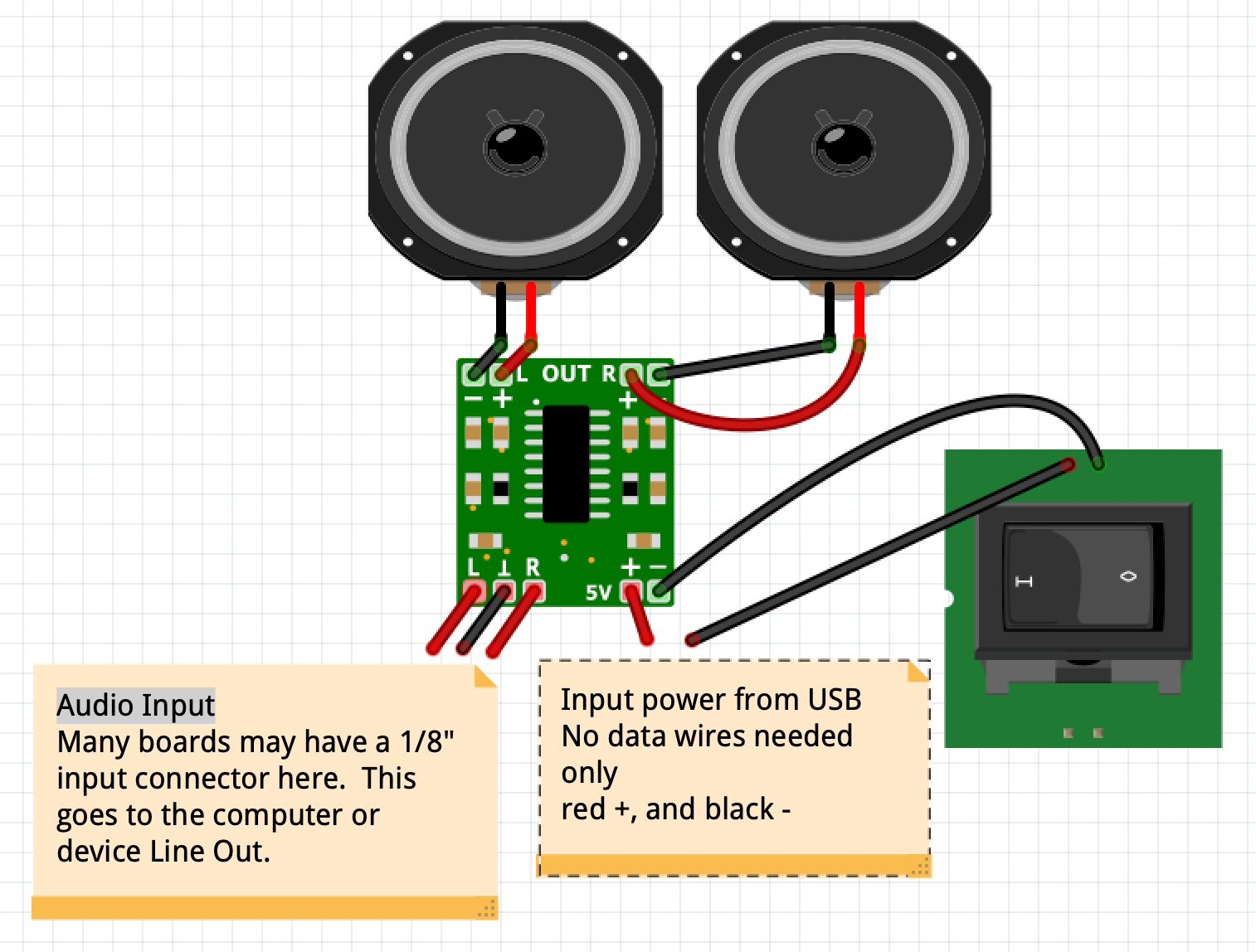
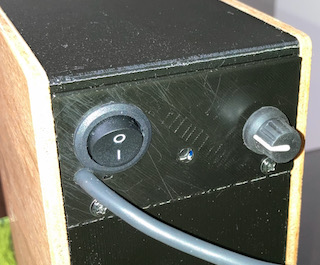
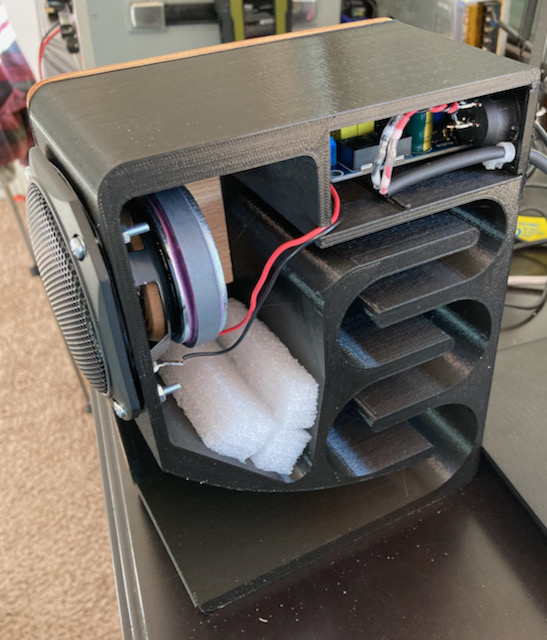
Fun project, thanks for sharing.
Pingback: 3D Printed Speakers: An Overview – Clonetronix
Pingback: 3D Printed Audio system: An Overview - 3DPrint.com - Live3DPrinters
AWESOME article and GREAT work…But HOW DID IT SOUND?! I made some folded horns using 8″ woofers about 20 years ago that were fantastic (hand wound crossovers and all). VERY interested in trying 3D printing (my buddy has Carbide Create and a system set up for large wood pieces!)
Cheers,
Mark
I got so excited to see this on thingiverse. The main enclosure started printing a few hours ago so I’ve been researching speakers.
My question is, are you satisfied with your speaker choice and what would you change if you built another set?
I actually still use these speakers but not together in stereo. I use one on a Uniden SDS200 police scanner and I use another one for audio on a Raspberry Pi project. Not sure what I’d change, if anything. It’s a cool little project.
Awesome project. Very interested in trying 3D printing, thanks for sharing.